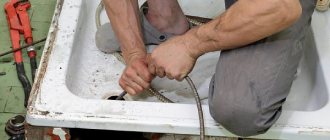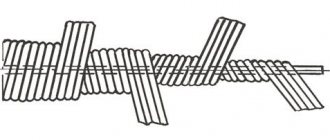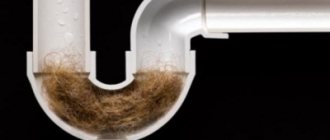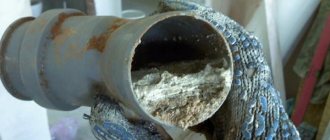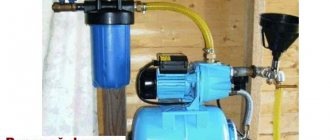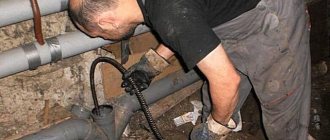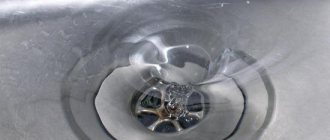To clean the sewer pipe, we use the common fast-acting preparation “Premium Pothan” - this is a solution of caustic alkali. Pour the product into the clogged pipe (approximately 70 g), then pour a glass of hot water and leave for 3-5 minutes. Then we flush the drain with a strong stream of hot water.
You can also use baking soda and vinegar. Pour half a pack of soda into the drain and add vinegar. Plug the drain with a plug. Wait 2 hours and rinse with boiling water (4-5 liters). If this does not help, use strong alkali-based preparations.
A blockage in pipes and its removal at home is an everyday matter, but in the process of cleaning the system, certain difficulties may arise. In this article we will look at many ways to solve this problem and how to avoid such a situation in the future.
In a modern private home it is impossible to imagine life without high-quality sewerage. It is best, of course, to install sewerage during the construction stage.
It is not difficult to install it, even on your own, without calling specialists. But there are points that you should pay attention to first. For example, an incorrect slope of a sewer pipe will often cause your pipeline to become clogged.
Causes and signs of clogged sewer pipes
One of the big troubles that you can often encounter is when the sewer system becomes clogged. Of course, this problem is not critical and to solve it there is no need to call a specialist - a plumber. Anyone can clean pipes at home without any special knowledge or tools.
You can understand that your system has become unusable due to the fact that it is clogged by the following factors.
- There is a bad smell coming from the bathtub, sink or toilet.
- The water began to drain much more slowly.
- The liquid level under the drain grate is too high.
To prevent sewer blockages, special screens and filters are widely used. But they cannot guarantee the occurrence of blockages.
Fats and oils that end up in drains with water and other waste often contribute to this problem. They accumulate on the walls, which leads to a decrease in the throughput of the system.
As a result of the formation of such plaque, drainage becomes difficult and may eventually stop completely. Blockages in a private home can also occur as a result of foreign objects entering the pipeline.
But still a common cause is organic waste. Cleaning in a private home can be done in the following ways:
- dry cleaning - carried out using products that have a caustic base;
- mechanical - using special tools;
- hydrodynamic cleaning under high pressure.
Regardless of the design and materials used, cleaning at home begins with disassembling the siphon.
There are several siphons in the house. Every sink and bathtub has this device. With its help, you can prevent unpleasant odors from coming from the sewer.
It is better to clean the siphon at home using various products. If the siphon is clogged, you can use boiling water and soda. This mixture allows you to eliminate the fat layer.
To make it, you need to add four tablespoons of baking soda to three liters of boiling water. You can increase the effectiveness of the solution by adding vinegar.
If you understand why this occurs, you can eliminate it quickly and without unnecessary complications. Knowing all the causes of blockages, you can prevent troubles. To do this, it is necessary to identify weak points in the sewer structure and carry out preventive measures in these areas of the drainage system. It is best not to delay and clean everything on time.
If this does happen, then the methods of elimination vary, depending on the sewer system. Also, to understand how best to clean pipes, you need to know what material they are made of.
Prevention
To prevent a clogged sewer from suddenly ruining your life, you should take care of the cleanliness of the pipes on a regular basis.
To do this you need:
- periodically flush the pipes with plenty of hot water;
- use special gratings to protect the drain from food debris, hair and other debris getting into it;
- equip the kitchen drain with a grease trap;
- periodically disassemble and wash siphons;
- periodically clean pipes with household chemicals;
- replace old steel or cast iron pipes, the internal diameter of which has significantly decreased over the years, with modern plastic analogues.
To combat sewer blockages, the main thing is not to wait until the pipe is completely blocked. Apply household chemicals at the first signs of decreased cross-country ability.
Differences in clogs
In buildings of the Soviet and post-Soviet period, cast iron pipes were mainly used. They have both pros and cons. The main disadvantage is that during operation they are subject to corrosion. Often, inside cast iron pipelines, the walls become uneven due to build-ups that form from rust and plaque.
Since a cast iron pipe can become too narrow in any part of the structure due to corrosion, it is very difficult to determine the location of the problem. Due to this, cleaning will be difficult.
Most often, cast iron products clog in the area coming out of the sink inside the kitchen, or the area coming out of the toilet. In a cottage, the sewer can become clogged in almost any area, but cleaning it in a hard-to-reach place is not so easy.
In plastic sewer systems this can occur due to incorrect installation. For example, the required angle of inclination was not taken into account. In this case, plaque forms inside, which needs to be cleaned to avoid further clogging.
Why do the pipes in the kitchen get clogged?
In everyday life, blockages most often occur in the pipes coming from the kitchen sink; they are caused by the following factors:
- The kitchen sink is mainly used for washing dishes and cooking utensils, so if the pipe is clogged, the first cause of the problem is food residues.
- Kitchen drains also become clogged with grease deposited on the inner pipe casing after washing dishes and food. Dirt and small organic waste stick to it, narrowing the passage channel and slowing down the flow of gray water.
- Incorrect installation of the siphon, a large number of bends or insufficient slope of the drain pipeline, its physical wear and tear can cause frequent blockages.
- Improper operation using predominantly cold water in the sink, lack of preventive cleaning and rinsing are the reasons why the sewer often begins to clog.
Rice. 2 Principle of hydraulic cleaning
Fatty plaque - removal at home
The most important reason for clogging of the sewer system was fatty deposits. It appears inside while washing dishes. Due to its high viscosity, fat retains small particles of debris, such as hairs, pieces of food, grains of sand and the like.
Subsequently, the sediment forms a thick layer, which reduces throughput. In a private home, fatty deposits are the worst enemy.
In order to prevent frequent blockages due to grease deposits, it is necessary to install grease traps. These devices will prevent clogging, and you will save significantly on the purchase of household chemicals.
These devices consist of special sections that retain fat and debris inside them. If a grease trap is installed, then you will not have a question about how to clean the drainage system in a private house.
But if grease deposits have nevertheless overtaken your sewer system, then with a quick response you can quickly eliminate everything. To do this, dry the sink completely with a dry cloth.
Then immediately pour boiling water inside the kitchen sink drain. If she starts to leave, then you need to continue the process. Once the blockage is cleared, flush the drain pipe with hot water.
You can clean a sewer pipe at home using regular soda and vinegar. In order to carry out this procedure, you need to follow it step by step.
- The kitchen sink is wiped dry.
- Pour one spoon of soda into the drain.
- Prepare a sink drain plug or an old rag.
- Pour half a cup of vinegar into the drain.
- Immediately close the sink opening.
Video - removing blockages at home using baking soda
